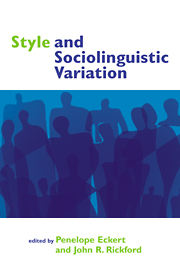Book contents
- Frontmatter
- Contents
- List of figures
- List of tables
- List of contributors
- Acknowledgments
- Introduction: John R. Rickford and Penelope Eckert
- Part I Anthropological approaches
- Part 2 Attention paid to speech
- Part 3 Audience design and self-identification
- 9 Back in style: reworking audience design
- 10 Primitives of a system for “style” and “register”
- 11 Language, situation, and the relational self: theorizing dialect-style in sociolinguistics
- 12 Couplandia and beyond
- 13 Style and stylizing from the perspective of a non-autonomous sociolinguistics
- Part 4 Functionally motivated situational variation
- References
- Index
13 - Style and stylizing from the perspective of a non-autonomous sociolinguistics
Published online by Cambridge University Press: 07 December 2009
- Frontmatter
- Contents
- List of figures
- List of tables
- List of contributors
- Acknowledgments
- Introduction: John R. Rickford and Penelope Eckert
- Part I Anthropological approaches
- Part 2 Attention paid to speech
- Part 3 Audience design and self-identification
- 9 Back in style: reworking audience design
- 10 Primitives of a system for “style” and “register”
- 11 Language, situation, and the relational self: theorizing dialect-style in sociolinguistics
- 12 Couplandia and beyond
- 13 Style and stylizing from the perspective of a non-autonomous sociolinguistics
- Part 4 Functionally motivated situational variation
- References
- Index
Summary
Coupland's paper – one of the most innovative and thought-provoking contributions in this volume – essentially consists of three parts: (1) a critique of quantitative sociolinguistic approaches to the analysis of style; (2) a proposal for a new approach in which dialect style as a marker of identity takes center stage, informed by goal-orientation and other concerns from communication theory; (3) an extract from a radio broadcast by a Welsh DJ, illustrating the new approach. I'll comment on each of these components in turn.
The critique of quantitative approaches to style
Coupland's critique of quantitative approaches to style ranges further and cuts deeper than the earlier, largely methodological, critiques that he cites. His is more conceptual, concerned with the underlying assumptions of quantitative stylistics (so to speak), which he lists as ten numbered points and elaborates on in subsequent sections. I won't repeat or comment on all of his points, but the overall thrust of the critique – directed at “the theoretical limitations inherent in an autonomous sociolinguistics” (emphasis added) – is one that I endorse, and have voiced before. For instance, to adequately account for the quantitative distributions by social class that we observe in local surveys of language use, we need to turn to sociological and anthropological models of social stratification and life mode, but these are quite unfamiliar to the average sociolinguist (Rickford 1986, Williams 1992, Milroy and Milroy 1992).
- Type
- Chapter
- Information
- Style and Sociolinguistic Variation , pp. 220 - 232Publisher: Cambridge University PressPrint publication year: 2002
- 7
- Cited by



